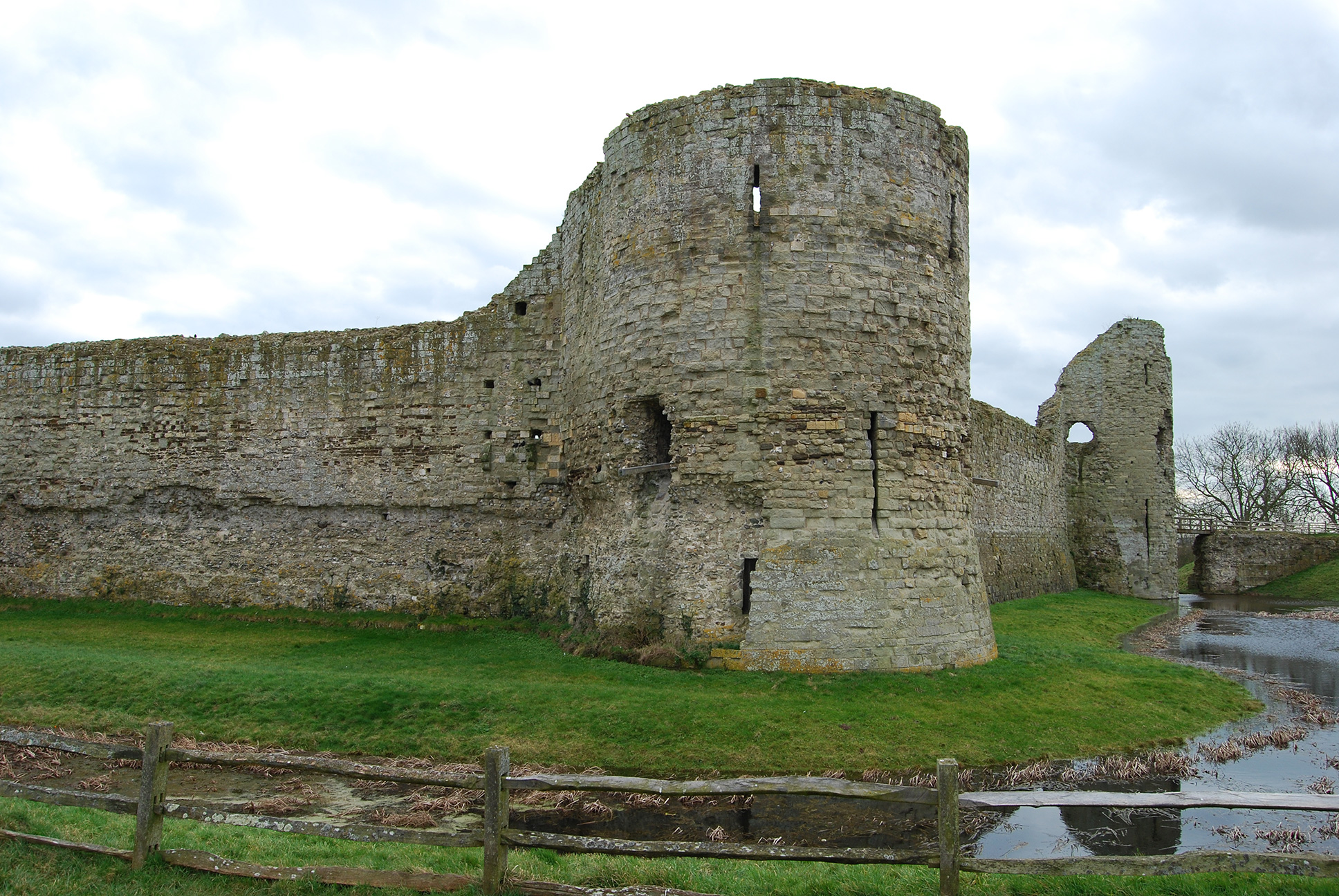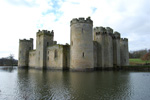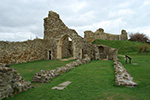History
Pevensey Castle resides in East Sussex, England, along the southern coast. Its strategic location near Pevensey Bay is why a fortification had existed here since around 290 when the Romans built the Saxon Shore fort of Anderitum. After the Roman occupation ended, the fort walls protected the area until at least the late 5th century.

In 1066, William the Conqueror set sail from France to challenge Harold Godwinson for the Crown of England. Inside his Viking long boats, William brought with him knights, horses, and wood to erect wooden palisade walls for protection. William and his army landed at Pevensey Bay. They quickly established a wooden castle within the old Roman stone ruins of Anderitum and refortified the fort's ruined walls. Two weeks later, they marched to nearby Hastings and constructed a second wooden castle. After defeating Harold at the Battle of Hastings, William began building wooden motte and bailey castles throughout England to control the country, thus starting the castle era.
In 1067, William granted Pevensey Castle to his trusted half-brother Robert, Count of Mortain, who was probably the first to build permanent medieval defenses at Pevensey. With Roman ruins serving as outer walls, the inner courtyard was divided into an inner and outer bailey separated by a ditch and wooden palisade. The inner bailey contained the medieval gatehouse, keep, and chapel, while the outer bailey encompassed more domestic buildings, including a granary.
After William died in 1087, contention over Pevensey Castle ensued between his sons, Duke Robert of Normandy and William Rufus, who served as heirs. Fearful that Duke Robert would attempt to attain control over the castle with his uncle's support, William Rufus launched a siege by land and sea to take control of it forcibly in 1088. The structure withstood six weeks of attack before a truce was declared after a food shortage broke the will of castle defenders.
For the next approximately 150 years, Pevensey Castle changed ownership through various royal favorites until 1246, when it was granted to Peter of Savoy, who replaced its wooden palisades with stone walls and towers, which still stand today.
On the 15th of May 1264, an army led by Simon de Montfort defeated the king's forces at the Battle of Lewes. Defeated members of the royalist army retreated to Pevensey Castle, pursued by de Montford's forces. The royalist constable of Pevensey was ordered to surrender Pevensey Castle. Upon his refusal, it was besieged for over a year before combat eventually ended due to its ongoing expense. After Peter of Savoy's death in 1268, Pevensey Castle passed to Henry III's queen, Eleanor of Provence, where it remained crown property for roughly 100 years.
In 1394, John of Gaunt appointed Sir John Pelham to serve as constable of Pevensey Castle. Five years later, Pelham departed the castle to support Henry of Bolingbroke when he usurped the English Crown from Richard II in 1399. During Pelham's absence, the castle was besieged by locals. His wife, Joan, wrote a letter to Pelham regarding her circumstances inside the castle during the siege.
My Dear Lord it is right that you know of my position, I am here laid in manner of a siege … so that I may not out, nor no vitals get without much difficulty. Wherefore my dear may it please you, by the advice of your wise council, to give remedy to the salvation of your castle and the malice of your enemies. The Holy Trinity keep you from enemies and soon send me good tidings of you.
J. Pelham.
The siege failed, and when Bolingbroke was crowned King Henry IV, Pelham received the castle and Honour of Pevensey in reward for his services. Henry IV's second wife, Joan of Navarre, was held prisoner at Pevensey Castle between December 1419 and March 1420 before being moved to Leeds Castle in Kent. She was charged with witchcraft and plotting to kill her stepson, Henry V.
The castle eventually fell into ruin during the Tudor dynasty, according to survey records of 1573. The threat of a Spanish Armada in 1588 required the construction of a gun emplacement at the castle, which consisted of two cannons. One still survives today within the inner bailey of the castle.
After the fall of France in World War II in 1940, Pevensey again became a potential location for invading England from the south. Consequently, a command and observation post was created within the castle, and perimeter defenses were refortified with modern machine gun pillboxes and a blockhouse for anti-tank weapons was built at the Roman West Gate. Moreover, the castle was repurposed to serve as barracks for a garrison during the war. The machine gun pillboxes within the medieval castle walls were left intact to remind of the castle's history.
Castle Highlights
After entering the Roman walls via Roman East Gate, the medieval castle and its inner bailey are visible to the left. It's a stone castle ruin similar to others in England. Upon remembering Pevensey Castle as the first fortification built by William the Conqueror nearly 1,000 years ago, its awe-inspiring history becomes evident. William would not recognize the castle today as it was simply a wooden motte and bailey when he erected it in 1066.
The gatehouse is one of the predominant features of Pevensey Castle. While it no longer consists of two majestic drum towers flanking the vaulted entranceway, the single remaining tower still conveys one of the earliest examples of this twin-tower medieval design. The postern gate that once provided access to the shoreline from the castle represents an additional noteworthy portion of the architecture. During sieges, it enabled ingress and egress of supplies to/from the castle unless besiegers restricted access to the sea. Moreover, the Roman walls of Fort Anderitum still exist around the medieval castle.
After being concealed under a dirt mound until rediscovery during the early 20th century, the foundations of the keep illustrate a stunning aspect of the castle. The impressions of two massive towers flanking the entrance suggest a great tower once comprising the keep and domestic apartments.
Since guided tours do not exist for Pevensey Castle, I highly recommend the purchase of a guidebook upon paying admission for entry within the gift shop. It contains helpful information as you explore the castle. There is also an audio tour available in the gift shop. An extensive visit only requires a hald day at best, an excursion to nearby Hastings Castle on the same day is suggested.
Pevensey Castle is also haunted.




